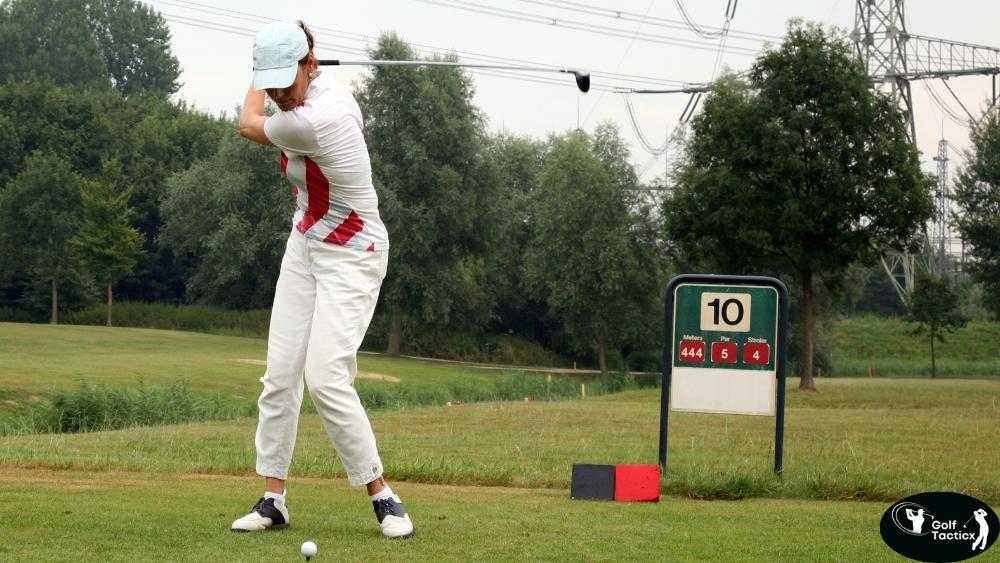In our previous posts, we’ve covered dialing in your wedge distances and developing spin control around the greens. Now, let’s focus on a crucial aspect of the short game: executing soft-landing, high-spinning bunker shots. Mastering this skill can help you navigate sand traps with confidence and precision.
High Spinning Bunker Shots require a blend of technique and feel, allowing the ball to pop out of the sand with enough backspin to stop quickly on the green. To achieve this, understanding how to adjust your stance, clubface angle, and swing speed is key.
Practicing these shots also builds versatility, letting you handle different bunker conditions, from wet, compact sand to fluffy, dry traps. With the right approach, you’ll turn intimidating bunkers into opportunities to showcase your finesse and save par with style.
Understanding Bunker Shots
Bunker shots are unique because they require you to strike the sand just behind the ball, lifting it out of the trap and onto the green. The goal is to achieve a high trajectory with a soft landing, allowing the ball to stop quickly and minimize roll.
Mastering this technique involves understanding how to control the club’s interaction with the sand to generate spin. The depth and speed of your swing determine how much sand is displaced, directly affecting the ball’s height and spin rate.
Adapting to the sand’s texture whether it’s firm or fluffy also plays a critical role in shot execution. Practicing in different bunker conditions helps you develop a feel for how much power and sand to take, ensuring you can consistently produce high-spinning shots that land softly and hold the green.
Why Soft-Landing, High-Spinning Bunker Shots Matter
Control: These shots enable you to stop the ball quickly, reducing the risk of it rolling off the green.
Versatility: Mastering this technique allows you to handle various bunker situations, including those with lip or tight lies.
Confidence: Knowing you can execute these shots effectively boosts your overall confidence around the greens.
Precision: High-spinning bunker shots give you the ability to target specific landing zones, helping you attack pins even in challenging bunker setups.
Course Management: By mastering these shots, you can strategically plan your approach, turning difficult sand traps into opportunities for up-and-downs.
Adaptability: This skill enhances your ability to adjust to unpredictable factors like wind or green firmness, ensuring consistent performance under pressure.
Key Elements of a Successful Bunker Shot
Proper Setup:
Stance: Adopt a wider stance with your weight favoring your front foot.
Ball Position: Place the ball slightly forward in your stance.
Clubface: Open the clubface to add loft and promote a higher trajectory.
Swing Technique:
Path: Use an outside-in swing path to help the clubface remain open at impact.
Follow-Through: Ensure a high follow-through to maintain loft and control.
Practice Drills:
Splash Drill: Focus on striking the sand just behind the ball to create a splash effect.
Open Face Drill: Practice hitting shots with an open clubface to enhance loft and spin.
Mental Preparation:
Visualization: Picture the ball’s flight and landing spot before swinging to build confidence.
Rhythm Control: Maintain a smooth, consistent tempo to avoid rushing and ensure proper contact.
Equipment Check:
Wedge Selection: Use a high-loft wedge (56-60 degrees) for optimal spin and control.
Grip Maintenance: Ensure clean grooves and a secure grip to maximize spin potential.
Common Mistakes to Avoid
Over-Swinging: Trying to hit the ball too hard can lead to inconsistent results.
Incorrect Ball Position: Placing the ball too far back in your stance can cause the club to dig into the sand.
Neglecting Follow-Through: A short follow-through can result in a low trajectory and less spin.
Ignoring Sand Conditions: Not assessing whether the sand is wet, fluffy, or compact can lead to misjudging the amount of sand to take, affecting shot consistency.
Rushing the Setup: Hurrying through your pre-shot routine can disrupt focus and lead to improper stance or grip, undermining your ability to execute high-spinning bunker shots effectively.
Adapting to Different Bunker Conditions
The ability to adjust your approach based on the sand’s texture and depth is critical for consistent high-spinning bunker shots. In wet, compact sand, the ball tends to sit higher, requiring a shallower swing to avoid digging too deeply. Conversely, in dry, fluffy sand, you’ll need to take more sand to ensure the ball pops out with enough loft.
Experiment with varying your entry point behind the ball, closer for firmer sand, farther back for softer conditions. Pay attention to the bunker’s slope and how it affects your stance; an uphill lie may demand a steeper swing to achieve the desired trajectory.
By practicing in diverse bunker setups, you’ll develop the adaptability to handle any course’s sand traps, turning challenging situations into opportunities for precise, spin-heavy shots that land softly and stick close to the pin.
Essential Pre-Shot Routine for Bunker Success
- Visualize the Shot: Before stepping into the bunker, imagine the ball’s path, from the sand to its landing spot, to build confidence and focus.
- Assess the Lie: Check the ball’s position and the sand’s condition to determine the right amount of swing power and sand to displace.
- Settle Your Stance: Dig your feet slightly into the sand for stability, ensuring a wide base to maintain balance during the swing.
- Practice Swings: Take a few rehearsal swings outside the bunker to feel the ideal swing path and speed for the shot.
- Breathe and Commit: Take a deep breath to calm nerves, then fully commit to the shot to avoid hesitation, which can disrupt spin and trajectory.
Comparing Wedge Types for Optimal Bunker Performance
| Wedge Type | Loft Range | Bounce Angle | Best Use Case | Spin Potential | Challenges |
|---|---|---|---|---|---|
| Sand Wedge | 54°–56° | High (10°–14°) | Soft, fluffy sand | High spin, ideal for standard bunker shots | Less effective in firm sand or tight lies |
| Lob Wedge | 58°–62° | Low to Medium (6°–10°) | Tight lies or high lips | Excellent for high, soft-landing shots with max spin | Requires precise control to avoid skulls |
| Gap Wedge | 50°–53° | Medium (8°–12°) | Firm sand or shallow bunkers | Moderate spin, good for longer bunker shots | Limited loft for high-spinning, short shots |
Conclusion
Mastering soft-landing, high-spinning bunker shots is a valuable skill that can elevate your short game. By focusing on proper setup, refining your swing technique, and practicing specific drills, you can navigate sand traps with confidence and precision.
To take your high-spinning bunker shots to the next level, incorporate visualization and adaptability into your practice routine. Picture the ball’s flight and spin before each shot to build mental clarity and boost consistency. Experiment with varying sand conditions to develop a feel for how different textures affect spin and distance.
Regularly clean your wedge grooves to ensure maximum spin control, as debris can reduce grip on the ball. Additionally, consider recording your practice sessions to analyze your technique and make small tweaks for better results.
With dedication to these elements, you’ll not only escape bunkers with ease but also impress your playing partners with pinpoint accuracy.
Stay tuned for our next blog post, where we’ll explore techniques for controlling trajectory in chip shots. Until then, keep practicing, and happy golfing!
















Leave a Reply